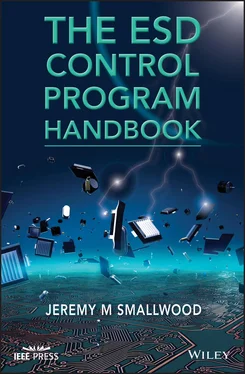
As the saturated vapor pressure increases strongly with temperature, if the amount of moisture present remains the same, increasing the air temperature will result in a reduction in relative humidity. Conversely, lowering the temperature will increase the humidity.
If the temperature is lowered sufficiently, the water vapor pressure eventually becomes equal to the saturated vapor pressure, and the air becomes saturated. Any further reduction in temperature may result in moisture condensing from the air on to surfaces in contact with it or in fog forming. This temperature is called the dew point .
1 Cross, J.A. (1987). Electrostatics Principles, Problems and Applications. Adam Hilger. ISBN: 0‐85274‐589‐3.
2 EOS/ESD Association Inc. (2014) ANSI/ESD S20.20‐2014. ESD Association Standard for the Development of an Electrostatic Discharge Control Program for – Protection of Electrical and Electronic Parts, Assemblies and Equipment (excluding Electrically Initiated Explosive Devices). Rome, NY, EOS/ESD Association Inc.
3 EOS/ESD Association Inc. (2015a) ANSI/ESD STM 11.11‐2015. ESD Association Standard for Protection of Electrostatic Discharge Susceptible Items – Surface Resistance Measurement of Static Dissipative Planar Materials. Rome, NY, EOS/ESD Association Inc.
4 EOS/ESD Association Inc. (2015b) ANSI/ESD STM 11.12‐2015. ESD Association Standard for Protection of Electrostatic Discharge Susceptible Items – Volume Resistance Measurement of Static Dissipative Planar Materials, Rome, NY, EOS/ESD Association Inc.
5 International Electrotechnical Commission. (2012) IEC/TR 61340‐1: 2012. Electrostatics – Part 1: Electrostatic phenomena — Principles and measurements. Geneva, IEC.
6 International Electrotechnical Commission. (2013) PD/IEC TS 60079‐32‐1. Explosive atmospheres Part 32‐1. Electrostatic hazards, guidance. Geneva, IEC.
7 International Electrotechnical Commission. (2015) IEC 62631‐3‐2. Dielectric and resistive properties of solid insulating materials ‐ Part 3‐2: Determination of resistive properties (DC methods) ‐ Surface resistance and surface resistivity. Geneva, IEC.
8 International Electrotechnical Commission. (2016a) IEC 61340‐5‐1: 2016. Electrostatics – Part 5‐1: Protection of electronic devices from electrostatic phenomena ‐ General requirements. Geneva, IEC.
9 International Electrotechnical Commission. (2016b) IEC 61340‐2‐3:2016. Electrostatics. Methods of test for determining the resistance and resistivity of solid planar materials used to avoid electrostatic charge accumulation. Section 3: Methods of test for determining the resistance and resistivity of solid planar materials used to avoid electrostatic charging. Geneva, IEC.
10 International Electrotechnical Commission. (2016c) IEC 62631‐3‐1. Dielectric and resistive properties of solid insulating materials ‐ Part 3‐1: Determination of resistive properties (DC methods) ‐ Volume resistance and volume resistivity ‐ General method. Geneva, IEC.
11 Jonassen, N. (1998). Electrostatics. Chapman & Hall. ISBN: 0 412 12861 6.
12 Lawrence, M.G. (2005). The relationship between relative humidity and the dewpoint temperature in moist air. A simple conversion and applications. Bull. Am. Meteorol. Soc.: 225–233. https://doi.org/10.1175/BAMS-86-2-225[Available from htt.s://journals.ametsoc.org/doi/pdf/10.1175/BAMS-86-2-225. Accessed 15th Aug. 2018.].
13 Wikipedia (2018) Ion, viewed 17 October 2018, [Available from https://en.wikipedia.org/wiki/Ion]
2 The Principles of Static Electricity and Electrostatic Discharge (ESD) Control
2.1 Overview
ESD stands for electrostatic discharge or, according to some, electrostatic damage. This chapter provides the basis of how static electricity arises and can lead to ESD in the real world. It also provides the principles that underlie ESD control techniques and equipment design.
Electrostatic charge can build up in a variety of ways. The charged object has an electrostatic field that could conceivably lead to an ESD event in several ways:
Direct breakdown of sensitive parts due to high electric field
Generation of an ESD event directly subjecting the part to discharge currents
Generation of an ESD event subjecting a part to induced transient electric or magnetic fields, or some other stress
At the root of any ESD event there is an object or surface that has a voltage that is different to its surroundings. Without this voltage difference, no electric field is present, and no ESD current can flow. Hence, the objective of ESD prevention measures has been to keep surface voltages and electric fields to a low level, below which damaging ESD cannot occur.
A review of the explanation of electrostatic charge build‐up and ESD sources included here quickly reveals many ways in which ESD risks can be generated in the real world. These are summarized in brief in this chapter.
2.2 Contact Charge Generation (Triboelectrification)
The first thing to state is that charge is never generated, nor is it ever destroyed. The phenomenon that we often describe lazily as the “generation” of charge is more correctly “separation.” Some practitioners speak of the charge being “liberated” or “set free.” The charge is initially present in the atoms that make up all materials. There are positive charges as protons in the atomic nucleus, and there are negative charges as electrons around the nucleus. Normally these are present in equal numbers so that in an uncharged atom the number of positively charged protons equals the number of negatively charged electrons present. Static electricity arises when an imbalance is created and the local amounts of positive and negative charge become different.
In practice, the amount of charge imbalance required to give strong electrostatic effects is surprisingly small. The limit of the amount of charge that can be built up on a surface is governed by the electrical breakdown field strength of air, around 3 × 10 6V m −1. The surface charge density required to give this field is only 2.64 × 10 −5Cm −2(Cross 2012). This is equivalent to about 1.7 × 10 14electrons m −2, or 8 atoms per million on the surface acquiring or losing an electron!
One common way in which static electrical charge imbalances can arise is when two materials make contact and then are separated. While in contact, electrons move from one material to the other at points of contact; this material gains a net negative charge, and the donor material gains a net positive charge. When the objects are separated, the negatively charged object can take its charge with it, leaving an equal positive charge on the other object. Although it is really charge separation that takes place, it is common to refer to the “generation” of static electrical charge.
2.2.1 The Polarity and Magnitude of Charging
The polarity of charge left on a material can be positive or negative and depends on a range of factors, especially on the other material with which it made contact. Materials may be arranged in a table according to the polarity of charge they take in contact with other materials, called the triboelectric series (see Table 2.1).
A material in the table (e.g. aluminum) can be expected to charge positively against another material below it in the table (e.g. polytetrafluoroethylene (PTFE)) and negatively against a material above it (e.g. wool). The amount of charge generated is a function of the separation of the materials on the table; aluminum and paper can be expected to charge relatively little against each other, but polyvinylchloride (PVC) and nylon can be expected to charge strongly against each other.
Читать дальше













